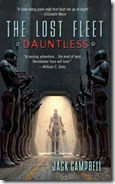 Here’s a review of a fun little series I got into back when Fictionwise was selling it in eReader format (well, they were selling most of it. Due to publisher confusion, they never got ahold of the first book in the series, so I had to read it by other means), and just recently finished when I found the last book on B&N.
Here’s a review of a fun little series I got into back when Fictionwise was selling it in eReader format (well, they were selling most of it. Due to publisher confusion, they never got ahold of the first book in the series, so I had to read it by other means), and just recently finished when I found the last book on B&N.
Suspended animation. It’s a really clever idea, and has been a staple of a number of science fiction stories—arguably since the original “Rip Van Winkle”. It’s a way to survive on space journeys lasting years, or in emergency situations when rescue might not come for years. The idea that people can “go to sleep” and wake up years later has provided the grist for a number of interesting tales.
Some of the ones I like best have to do with the times someone ends up sleeping longer than he or she ever intended. There’s the case of Ripley in Aliens, for instance, who woke up to find her own daughter had lived a long life and then passed away. Lunzie in Anne McCaffrey’s Dinosaur Planet series (followed up by Jody Lynn Nye in her co-written tie-in The Death of Sleep) was another such case. John Spartan in Demolition Man provided filmmakers with a chance to disguise some biting social commentary as an action movie. And I can’t forget the protagonist of one of my favorite TV shows, Avatar: The Last Airbender. And so on.
The idea of someone having to adjust to being thrust forward on a one-way journey into a world where many or all of the people they’ve known are dead is fascinating to me. And John G. Hemry, writing under the pseudonym of Jack Campbell, has managed to create an even more fascinating story than most in his 6-book series The Lost Fleet, available as paperback-priced e-books from Amazon, Barnes & Noble, and other places e-books are sold. He uses the device of suspended animation to combine ideas from Rip Van Winkle and the legend of King Arthur: what if an ordinary man woke up to find himself a legendary hero?
Alliance Navy Commander John “Black Jack” Geary fought a valiant rear-guard action against a surprise attack from neighboring star nation the Syndic, giving his life to hold the Syndic forces off long enough for his crew and a convoy his ship was protecting to make its escape. In the century of war that followed, the Alliance turned a posthumously-promoted Captain Geary into a heroic example to inspire the troops, building up a legend around him that no man could hope to live up to.
And then, on the way back through the star system where that fatal battle took place, an Alliance battle fleet primed to strike at the heart of Syndic space discovered an escape pod drifting in space, its emergency beacon damaged—and within, a cryogenically-preserved Captain John Geary, who it turned out had not died with his ship after all.
As Geary tried to recover from the lingering effects of his sleep, and the knowledge that everyone he ever knew in his life had been dead for decades, the admiral in charge of the fleet placed another burden on his shoulders. The fleet had been betrayed and decisively defeated in battle—and the admiral in charge asked and ordered Geary to get the fleet, and the precious key to the enemy’s hyperspace gateway system that had been used to lure them into this trap, safely home if something happened to him.
Hours later, the admiral had been gunned down in cold blood by the Syndic fleet commander with whom he went to negotiate—and Geary, who was the most senior captain in the entire fleet by almost a hundred years but the most junior in terms of actual command experience, began to find out just what a mess he’d landed in.
Over the course of a hundred years of bloody war, much of the art of war had been lost as the keepers of the knowledge died before they could pass it on to the next generation. Space battles were reduced to artless slugging matches, and naval culture came to value the bravery embodied in reckless death-and-glory charges above all else—after the example of legendary hero “Black Jack” Geary. Discipline was lax, salutes were unheard of, and fleet decisions were rendered by vote rather than adherence to chain of command—and the rules of war considering humane treatment of prisoners and forbearing from attacks on civilian targets were honored more in the breach than the observance.
But the lost arts of strategic fleet warfare, discipline, and honor were embodied in Captain Geary, who vowed to rekindle them in the present-day beginning with the fleet fate had given him. He would strive to take the fleet home—but the way there was littered with more obstacles than just Syndic battle fleets. Not all of the fleet’s captains were comfortable with the new command and fighting style, and along the way hints began to surface of a darker secret behind the war that had raged for a hundred years.
As if that wasn’t enough, Geary had personal problems to contend with in the form of two women close to him: a cold politician who distrusted him on principle, and a flagship captain who he was concerned trusted him him too much. His relationships with these women added complication to an already complicated situation.
And on top of it all, he had to deal with the legend that had grown up around him, turning him into a figure that even he had a hard time recognizing. Though Geary didn’t see himself as anything more than an ordinary sailor tossed out of time by a twist of fate, to the sailors around him he was a legend returned from beyond the grave—which is a lot to live up to.
This was a fun and exciting series to read for a number of reasons. The storyline had a lot of hooks that attracted me, most notably the aforementioned examination of how suspended animation could take someone out of time. But the idea that one could go to sleep an ordinary man and wake up a legendary hero a hundred years later—to his chagrin—is very clever, and I’m surprised I haven’t seen it done before.
Geary is an interesting character. He’s basically an ordinary man (and he clings to this fact like a life preserver in the light of the hero-worship from the rest of the fleet). An honorable man, and well-educated in the arts of war from his own era, but nowhere is there any suggestion that he is some sort of battlefield prodigy—except by comparison to two navies that have entirely lost those arts.
So, ironically, he ends up living up to the legend of “Black Jack” Geary not because of actually possessing any legendary qualities, but because everybody else has entirely lost the qualities that were normal in his day. As the old saying goes, in the land of the blind, the one-eyed man is king.
Another interesting thing, that I don’t recall seeing in other space-navy books, is the depiction of the challenges and opportunities brought by speed-of-light sensor limitations. In maneuvering the fleets, a commander has to get a sense of when to order certain maneuvers, because it will take several minutes for the light that reveals what each combatant is doing to reach the other. Hence, space battles become more like submarine warfare rather than straight up naval broadsides, as each side has to guess what the other is doing while at the same time trying to fool them into thinking he’s doing something else.
There are a couple of points I’m not as fond of about these books, though. One thing I find a little hard to swallow is that a religion of star- and ancestor-worship has come to dominate the entire galaxy, to the point where Christianity is never mentioned at all. Of course, from a storytelling standpoint this is a thematic element that drives home the point that Geary effectively is one of those worshipped ancestors coming back to save the day, but it seems a trifle unrealistic that Christianity could just up and vanish over the course of a few hundred years.
The other thing is not so much bad as it is a stylistic choice. The books are written in a strict third-person-limited viewpoint, focusing on the internal thoughts and perceptions of Geary. After reading the Honor Harrington series in which everyone’s point of view was narrated by turns, it seems a little like wearing blinders to read a space navy series where you only get one point of view and don’t have any more idea of what the enemy is thinking than Geary does. It’s really a silly thing to find annoying, though.
After six books, the series reaches a stopping point that could qualify as a conclusion if nothing more was ever written in the universe. I’m sure it was planned that way just in case it didn’t sell well enough to merit sequels. But happily, there’s going to be a second Lost Fleet series, “Lost Fleet: Beyond the Frontier,” that continues the story from there. The first book in it will be released at the end of this month. (Less happily, it appears this series will be published in hardcover first, rather than paperback the way the others were, and hence will start with a hardcover e-book price of $12.99. Ugh.)































Extreeeemely minor nitpick here, but “The Death of Sleep” was co-written by Jody Lynn Nye, I believe. Elizabeth Moon did indeed co-author a tie-in to McCaffery’s Dinosaur Planet/Planet Pirates series, but that was “Generation Warriors.”
Thanks for reminding me. Fixed it.
Last I read there are actually two spin off series. ‘Beyond the Frontier’ as mentioned above and ‘Phoenix Rising’ which will focus on the collapse of the Syndicate Worlds.
Some might also be interested in Hemry’s earlier series’ ‘Stark’s War’ (3 books), and JAG in Space’ (4 books) both of which are available from Webscription for $5 each or all seven for $30.
Generally I like that you review good science fiction, but it would be so much better if you reviewed some good science fiction I haven’t already read.
Johan: Sorry. Can I help it if you have such good taste in books? 🙂
“Hey, you know what would be *awesome*? If someone, like, combined Honor Harrington and Battlestar Galactica!”
By the way, did you know that battlecruisers are as heavily-armed as battleships but very lightly armored, which makes them very vulnerable?
Amazon UK ebook price: £6.39
http://www.amazon.co.uk/dp/B005G517PQ/
Amazon UK paperback price: £4.49
http://www.amazon.co.uk/dp/0857681303/
I’ve reported the lower price. I suspect it’s a side effect of the paperback and the ebook edition not being linked properly. (The paperback still has a “Tell the Publisher I’d like to read this book on Kindle” link.)